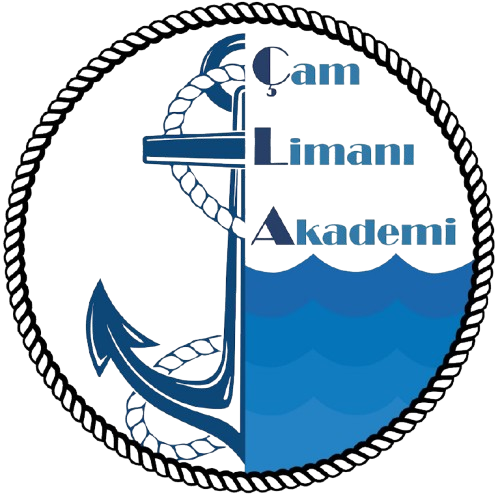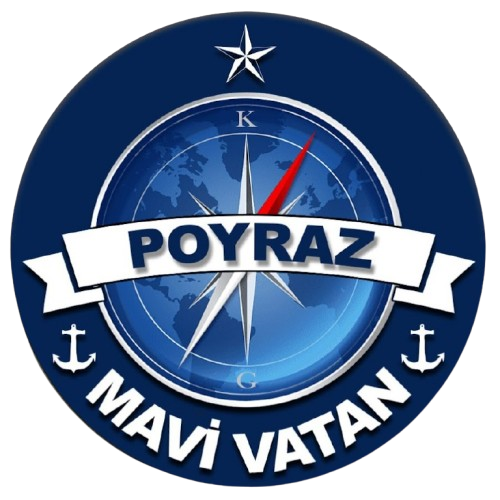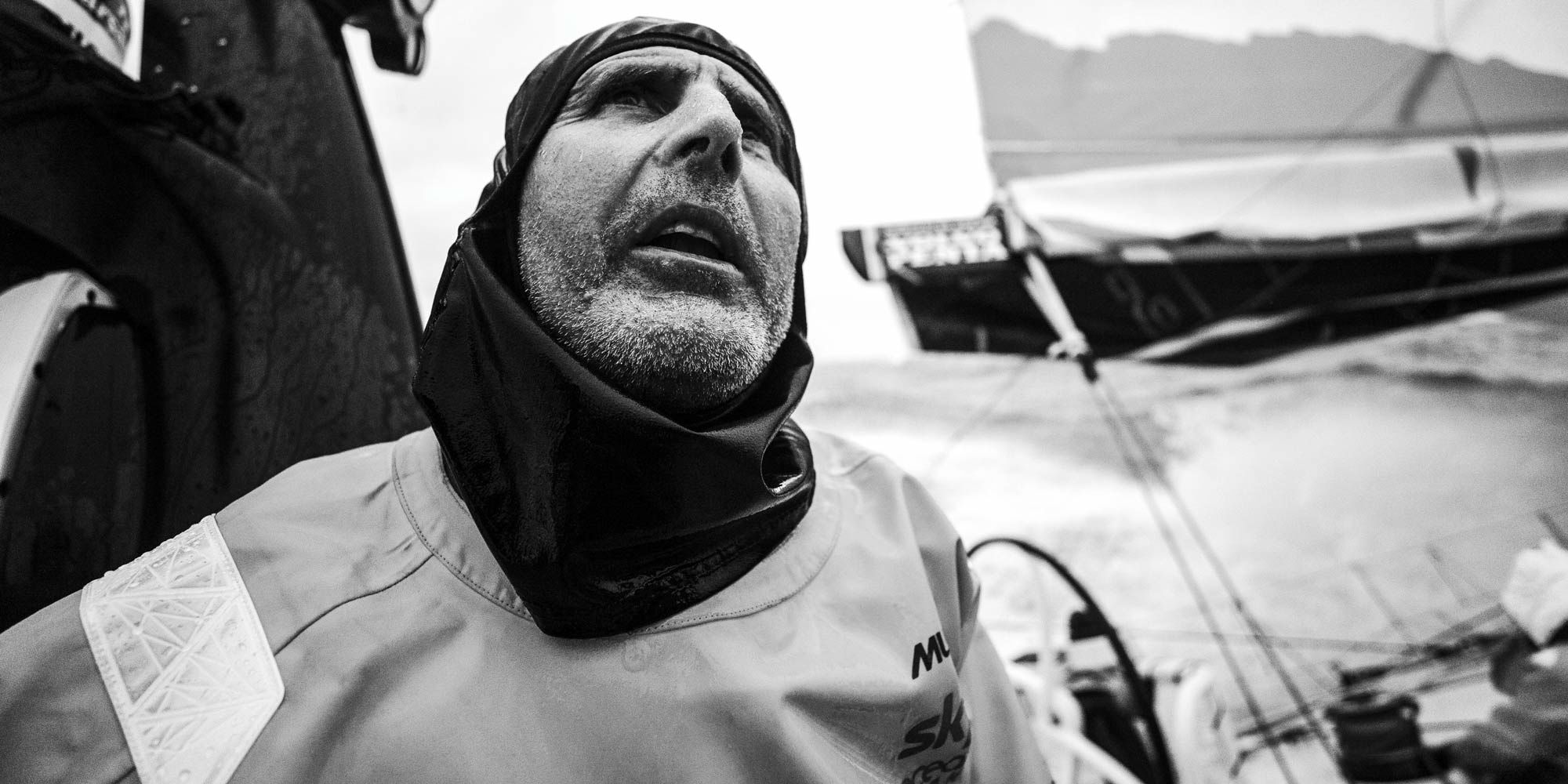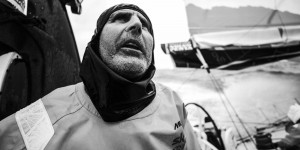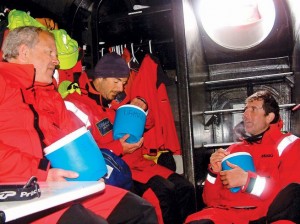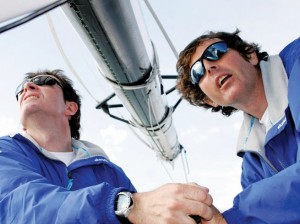In a career stretching back 25 years since Brian Thompson set a class record in the OSTAR singlehanded transatlantic race, he’s gone on to break sailing speed records on more than 40 occasions, everything from a circumnavigation of the planet to a circumnavigation of the Isle of Wight. Speed records bring to mind a certain intensity in a man, yet the day we meet for coffee during a short break from the Volvo Ocean Race, Thompson is anything but intense. He was supposed to do all legs of the race with Dee Caffari’s young crew of Turn the Tide on Plastic, but he broke his leg four months before the start.
The accident happened in Long Beach, California, in the days before the Transpac race start with Lloyd Thornburg’s MOD70 Phaedo. Thompson walked off the end of a dock in the pitch-black night. “No lighting, no barriers or anything. It was quite a high dock, and I fell into the water,” he says. “I’m not entirely sure how I broke my leg. I think it just remained on the dock and got twisted, but it was totally broken and loose.
“I was in the water, in the dark, and I’m only here because two people were playing guitars on the dock above me. They pulled me out. It was a strange dock, with no ladders to get out. It was about a meter tall; you couldn’t climb out with a broken leg. So, I was pretty lucky.”
It is extraordinary to think that Thompson might have ended his days drowning just a few feet from a dock, after surviving 30 years of everything the ocean could throw at him in some of the fastest, meanest sailboats on the planet. It wasn’t his time.
Thompson was born in 1962 in Scunthorpe, an industrial town on Britain’s northeast coast, which seems an improbable place to start an ocean racing career. But not as improbable as where his family went next, to Middlesex — inland, and prime London commuter country — when Thompson was 18 months old.
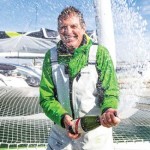
The family ended up joining the Royal Corinthian YC at Burnham‑on-Crouch, which has a famous junior program. “We ended up getting a caravan down there. So that was our holidays. We didn’t really take any other holidays; we went down there for the summer or for weekends during the year. We did a lot of driving to go sailing. It was all dinghy sailing: crewing on Mirrors or Cadets. Then I got a Heron [dinghy] that I could sail in the winter, breaking ice.”
“I took the Heron to Burnham in the summers, and then I’d just go off sailing on my own, which I’m sure you wouldn’t be allowed to do now. No rescue boat; I used to sail to the pub. I’d take me and my dog and just go. I was 11 or 12. So that was my first taste of singlehanding.
“I remember coming back at 10 at night, thinking my parents would be annoyed with me for being out so late, and they weren’t at all worried about it. Or they appeared fine. Maybe they were just glad I got back. You’d feel too guilty, now, as a parent, doing that. But it was a great experience.”
Thompson was also an enthusiastic participant in the Duke of Edinburgh’s Award, a youth achievement program that encourages and rewards children at bronze, silver and gold levels in four different areas: service, learning skills, physical recreation and an adventurous journey. “I did all the levels of that, so all the hiking on my own and in a group, making my own decisions. I was happy on my own and happy being in the wild.”
Thompson was also an avid reader of books about and by the ocean racing stars of the day. “The ones who left from here [the British Isles], so Chichester, Rose, Knox-Johnston, and then the French ones, like Bernard Moitessier and Tabarly.”
He was also racing dinghies, eventually the ubiquitous Laser. “I was quite good, but not a gifted dinghy sailor. I never actually thought about going to the Olympics. It wasn’t a very easy path then. I did think about having more adventures or doing longer trips. Even in other sports, I was always much better at long-distance swimming than sprinting, or long-distance running than sprinting, and I actually liked the longer events.”
The transformation from dreams to reality began after university, where Thompson studied economics. “I took a gap year after university, and thought I’d go traveling around Europe on a motorbike. Then, randomly, in Gibraltar I met a guy who was skippering a Swan 48 in the summer and was a ski instructor in the winter. I thought, That sounds like fun; you get paid to travel a bit more.”
The advice he was given was to go to Palma, walk the docks and look for a job. “I rode my bike to Valencia and got on a ferry. I was 21 or 22 then, and I think I spent five weeks doing day work. Then I got a job on an old maxi yacht called Mistress Quickly, which had been winning races.”
Thompson did a season with the classic maxi, learning from its sailors, all of them Whitbread veterans, before sailing to the Caribbean. His parents had retired to go cruising and were making a timely trip. “My first Atlantic crossing was with the two of them, which was really nice, on an Oyster 39, which was a good, solid boat.”
He soon got a job in the Caribbean, skippering a catamaran, before moving to a Swan 48 that he worked on for five years, winning the Newport Bermuda Race and the Pineapple Cup along the way. He was learning a lot, but he was also still reading. “That’s kind of how I learned, by reading about it,” he says. “Everyone learns in different ways.”
And then one day there was one of those transformative experiences that changes the direction of a life. In June 1988, he was in Newport, Rhode Island, when the dock he was tied to suddenly swarmed with French journalists. “This crazy trimaran called Fleury Michon turned up on the dock with a guy wearing a beret, like a train driver’s cap. That was Philippe Poupon, and he’d just sailed across the Atlantic in 10 days [winning the 1988 OSTAR].
“I’d been sailing for five years on the Swan 48 and never done a 300-mile day, and he’d averaged 300 miles a day on his own, upwind. I realized then that I was on the wrong kind of boat.”
Thompson already had an interest in the BOC Challenge around‑the-world race, and had been to see the start. Poupon rekindled his interest in singlehanded sailing. “I thought, OK, I’ll try to do that race on a trimaran. I didn’t really think about sponsorship, but because I’d been working for five years on the Swan, I’d saved up a little bit of money.”
He traveled to Maine and bought a 35-foot trimaran from Rich Wilson, who had done the 1988 OSTAR and won his class in it.
The boat was Curtana, and Thompson’s first endeavor was the 1990 TwoSTAR Race. A beam broke halfway across the Atlantic, and he took 13 days to nurse it back home. “That was a great experience because the boat had no engine, but a great big wing mast, so I had to sail it in and out of marinas and get used to sailing trimarans.”
Thompson was hooked. He gave up running boats to concentrate on racing his trimaran and paid for it by skippering a seismic survey vessel. In 1992, he completed the OSTAR and won Class 5, setting the class record, which stands to this day. He sold the boat soon after, but he was accomplished enough to get noticed, and things started to happen quickly. Dick Skipworth offered a loan of his trimaran for the Round Britain Race, a two-handed race, which Thompson sailed with Helena Darvelid. The pair won their class and were second overall in the 35-foot Severalles Challenge, setting a new Class 5 record.
Thompson’s performance was noticed by Steve Fossett and Dave Scully, who won the race overall with the 60-foot trimaran Lakota. “It was their first race in the boat, and I think they were already hatching plans for their next event,” Thompson says, “which was to break the Fastnet Race course record. I guess they were looking for crew, and they asked if I wanted to come along.”
Lakota started as a pirate entry behind the rest of the Fastnet Race fleet because no multihulls were allowed in those days. They had passed everyone by the Needles, and went on to set a record for the Fastnet and back. “It was 1993. We did a lot that year. We did three world records. They were the first that Steve did in sailing. Maybe his first world records, actually. There were so many.”
Thompson became a core member of Fossett’s team as they assaulted the record books. From 1993 to 2004, they set 23 official world records and nine distance race records. It was a period that culminated with a circumnavigation record in the enormous 125-foot Cheyenne (formerly PlayStation).
“The round-the-world record on Cheyenne was, for me, a culmination of 11 years of sailing with Steve. He was the most inspiring person. He was always positive and logical, and never afraid of taking his own path. It had been his dream since the early 1990s to break this record above all others, and to get to that point took a decade, three great multihulls and many other records and races. I was fortunate enough to participate in most of that journey with him, and to also meet so many of the people that also traveled with Steve on water, or in the air.”
Fossett disappeared in a plane crash — which was eventually revealed to have killed him — in September 2007. “That was very shocking,” Thompson says. “In fact, very strange, the fact that it took months. There were weeks of searching and not knowing what was happening, and then having a memorial service, and then months and months and months later, they found the body. Probably a year later, yes. But no, an exceptional man, so very lucky to have met him.
“Really, from sailing that trimaran, by chance, I met Steve and Dave Scully, and then started working for him. So, it was all from taking a risk and buying that trimaran. I’m not the best person at looking for sponsorship. After that [the PlayStation era], I thought I’d get back to singlehanding and do the Mini-Transat. So again, I bought my own boat, and went sailing with the money I’d saved.”
Thompson still has personal goals to strive for. The Figaro is a striking omission from his resume, and he’d love to do a solo multihull around-the-world record attempt.
Thompson came fifth in the Mini-Transat. “I really should have done a little bit better. I got pipped at the post, but anyway, it was still great to do, and then to realize I could keep up with the crazy French people, downwind, in a 21-footer. I thought they were mad or extraterrestrially talented, but I guess with the things I’d done, I’d got that experience to be able to do it, so that was good. It gave me the confidence to think I could do something like the Vendee.”
This was a box that Thompson ticked in the 2008-2009 edition. He had done a leg of the Volvo Ocean Race with Mike Sanderson’s all-conquering ABN AMRO in 2005-2006. When Sanderson couldn’t complete his own Vendee Globe campaign with Bahrain Team Pindar, he handed the project over to Thompson.
“I’ve known Brian for many years,” Sanderson says. “A true gentleman of the sport and an amazing quiet achiever. I have worked with him now on many programs, and my wife, Emma, sailed with him on Tracy Edward’s Maiden 2 campaign. Brian was an obvious replacement on ABN AMRO when we needed a hardworking talented trimmer/driver for the Southern Ocean leg to Melbourne. Brian instantly fit in, and without bringing a whole new ego on board. Following that experience, it was a no-brainer to recommend Brian to Andrew Pindar to take over as the skipper of the Pindar Open 60 program. Brian then went on to do a fantastic Vendee Globe campaign.”
The Vendee campaign was not without its challenges. Thompson dismasted twice before the start. “I wasn’t able to do any racing before the Vendee,” Thompson says. “So it was the only boat that finished the race, not having done a race before. It hadn’t been tested. Hence why we had so many issues.”
Outside of his own singlehanded racing exploits, Thompson has also sailed with and against a remarkable succession of the great names in offshore racing. One such competitor is British solo and shorthanded offshore sailing star Mike Golding. Thompson raced with him in the Transat Jacques Vabre in 2003.
“Brian has always been refreshingly approachable and easy to get along with,” Golding says. “He has a deep understanding of what makes raceboats fast, and — while he is as technically proficient and analytical as the best — what I admire most is that he is still driven predominantly by a true sailor’s instinct for what is actually right.”
And then there is Caffari, the only woman to have sailed singlehanded, nonstop around the world in both directions. Caffari tapped Thompson for her ambitious Turn the Tide on Plastic Volvo Ocean Race effort, crewed primarily by young, green and aspiring ocean racers on their first lap of the planet.
“Brian is one of the genuinely nice people in the sport,” Caffari says. “I’ve raced with him and against him, and I knew that he wasn’t afraid to pass on his experience. The driving force behind my team was that 80 percent of them were under 30, and I needed someone who could communicate their knowledge on board. He was also someone I could trust. Nothing fazes him. He’s relaxed and calm, and nothing flaps him. The atmosphere on board comes from the top, and it was very important to get someone that would help me create that atmosphere. So even when the boat was on the edge of control at times, we just communicated that this was normal and how it was, and the crew picked up on that and got on with it.”
On the receiving end of that experience was Bleddyn Môn, a 26-year-old Welshman doing his first VOR aboard Turn the Tide. “I was fortunate to be able to work closely with Brian on the instrumentation and performance side of the campaign. He was a great person to discuss and bounce ideas off. Open minded and never rushing to an answer, he’ll always think about it carefully first,” Môn says. “As you’d expect, he is very level offshore, and would be open to discussion and always happy to talk through the plan and what he was expecting next.”
Despite a remarkable career to date, including the most recent record-breaking exploits with Thornburg’s Phaedo, Thompson still has personal goals to strive for. The Figaro is a striking omission from his resume, and he’d love to do a solo multihull around-the-world record attempt.
“I’ve wanted to do that since the 1990s, before even Francis Joyon had ever done it,” he says. “But not being the world’s expert at getting sponsorship, it hasn’t happened. They’re having a solo round-the-world race next year, and I’d love to be able to do that. To do it, and then help build a team, where another British sailor can do it after me, and hopefully, start winning those races.”
When pressed to pull one highlight from the pages of accomplishments, the 1992 OSTAR comes first, Thompson says. “Then, the highlight of sailing with Steve was the round-the-world record. I should count them up [the records], but it will be 40ish.”
One day, he adds, he’d like to do some proper cruising, perhaps the South Pacific, having sailed past it 10 times without stopping. “I never turned left, like Moitessier. One day, I’ll do it like Moitessier, and do it properly.”
Meanwhile, he’s going back to his roots.
“I help look after a Swan 44 for a friend,” he says. “I take the kids out on it a lot, so it’s kind of gone full circle. It’s an S&S Swan of that same era [that he began working on], so now I’m back, looking after an elderly Swan with lovely teak decks, and taking the kids out on that.”
Source: sailing world


